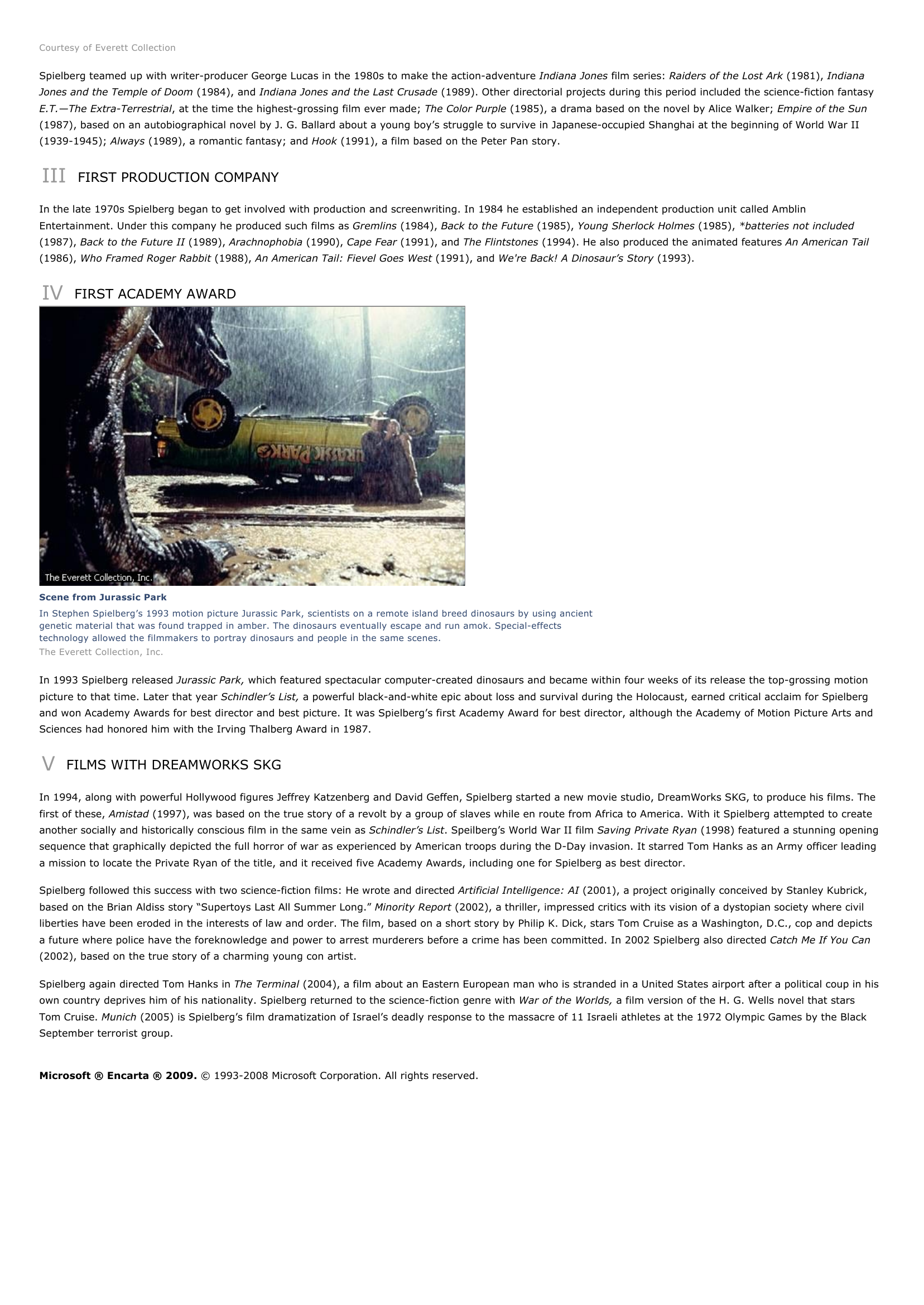Steven Spielberg I INTRODUCTION Steven Spielberg The imaginative films of Steven Spielberg are known for their technical creativity and memorable characters.
Publié le 12/05/2013

Extrait du document
«
Courtesy of Everett Collection
Spielberg teamed up with writer-producer George Lucas in the 1980s to make the action-adventure Indiana Jones film series: Raiders of the Lost Ark (1981), Indiana Jones and the Temple of Doom (1984), and Indiana Jones and the Last Crusade (1989).
Other directorial projects during this period included the science-fiction fantasy E.T.—The Extra-Terrestrial , at the time the highest-grossing film ever made; The Color Purple (1985), a drama based on the novel by Alice Walker; Empire of the Sun (1987), based on an autobiographical novel by J.
G.
Ballard about a young boy’s struggle to survive in Japanese-occupied Shanghai at the beginning of World War II(1939-1945); Always (1989), a romantic fantasy; and Hook (1991), a film based on the Peter Pan story.
III FIRST PRODUCTION COMPANY
In the late 1970s Spielberg began to get involved with production and screenwriting.
In 1984 he established an independent production unit called AmblinEntertainment.
Under this company he produced such films as Gremlins (1984), Back to the Future (1985), Young Sherlock Holmes (1985), *batteries not included (1987), Back to the Future II (1989), Arachnophobia (1990), Cape Fear (1991), and The Flintstones (1994).
He also produced the animated features An American Tail (1986), Who Framed Roger Rabbit (1988), An American Tail: Fievel Goes West (1991), and We're Back! A Dinosaur’s Story (1993).
IV FIRST ACADEMY AWARD
Scene from Jurassic ParkIn Stephen Spielberg’s 1993 motion picture Jurassic Park, scientists on a remote island breed dinosaurs by using ancientgenetic material that was found trapped in amber.
The dinosaurs eventually escape and run amok.
Special-effectstechnology allowed the filmmakers to portray dinosaurs and people in the same scenes.The Everett Collection, Inc.
In 1993 Spielberg released Jurassic Park, which featured spectacular computer-created dinosaurs and became within four weeks of its release the top-grossing motion picture to that time.
Later that year Schindler’s List, a powerful black-and-white epic about loss and survival during the Holocaust, earned critical acclaim for Spielberg and won Academy Awards for best director and best picture.
It was Spielberg’s first Academy Award for best director, although the Academy of Motion Picture Arts andSciences had honored him with the Irving Thalberg Award in 1987.
V FILMS WITH DREAMWORKS SKG
In 1994, along with powerful Hollywood figures Jeffrey Katzenberg and David Geffen, Spielberg started a new movie studio, DreamWorks SKG, to produce his films.
Thefirst of these, Amistad (1997), was based on the true story of a revolt by a group of slaves while en route from Africa to America.
With it Spielberg attempted to create another socially and historically conscious film in the same vein as Schindler’s List .
Speilberg’s World War II film Saving Private Ryan (1998) featured a stunning opening sequence that graphically depicted the full horror of war as experienced by American troops during the D-Day invasion.
It starred Tom Hanks as an Army officer leadinga mission to locate the Private Ryan of the title, and it received five Academy Awards, including one for Spielberg as best director.
Spielberg followed this success with two science-fiction films: He wrote and directed Artificial Intelligence: AI (2001), a project originally conceived by Stanley Kubrick, based on the Brian Aldiss story “Supertoys Last All Summer Long.” Minority Report (2002), a thriller, impressed critics with its vision of a dystopian society where civil liberties have been eroded in the interests of law and order.
The film, based on a short story by Philip K.
Dick, stars Tom Cruise as a Washington, D.C., cop and depictsa future where police have the foreknowledge and power to arrest murderers before a crime has been committed.
In 2002 Spielberg also directed Catch Me If You Can (2002), based on the true story of a charming young con artist.
Spielberg again directed Tom Hanks in The Terminal (2004), a film about an Eastern European man who is stranded in a United States airport after a political coup in his own country deprives him of his nationality.
Spielberg returned to the science-fiction genre with War of the Worlds, a film version of the H.
G.
Wells novel that stars Tom Cruise.
Munich (2005) is Spielberg’s film dramatization of Israel’s deadly response to the massacre of 11 Israeli athletes at the 1972 Olympic Games by the Black September terrorist group.
Microsoft ® Encarta ® 2009. © 1993-2008 Microsoft Corporation.
All rights reserved..
»
↓↓↓ APERÇU DU DOCUMENT ↓↓↓
Liens utiles
- Luciano PavarottiIINTRODUCTIONLuciano PavarottiRenowned Italian tenor Luciano Pavarotti was known for his mastery of the highest notes of a tenor's range and for hisjovial personality, which helped him earn a wide popular following.
- Akira Kurosawa Akira Kurosawa (1910-1998), Japanese motion-picture director, known worldwide for the variety and visual beauty of his films.
- Temperature I INTRODUCTION Thermometers Mercury and digital thermometers are the most common types of household devices for measuring body temperature.
- Nicolaus Copernicus I INTRODUCTION Nicolaus Copernicus (1473-1543), Polish astronomer, best known for his astronomical theory that the sun is at rest near the center of the universe, and that the earth, spinning on its axis once daily, revolves annually around the sun.
- Albert Einstein I INTRODUCTION Albert Einstein (1879-1955), German-born American physicist and Nobel laureate, best known as the creator of the special and general theories of relativity and for his bold hypothesis concerning the particle nature of light.










